Effect of Mo on Microstructures and Wear Properties of In Situ Synthesized Ti(C,N)/Ni-Based Composite Coatings by Laser Cladding
Abstract
:1. Introduction
2. Materials and Methods
3. Results and Discussion
3.1. Phase Constituent Analysis
3.2. Microstructure Analysis
3.3. Micro-Hardness and Wear Resistance
4. Conclusions
- (1)
- In this paper, using Ni60 alloy, C, TiN and Mo powders as the precursor materials, in situ synthesized Ti(C,N) reinforced Ni-based composite coatings are produced on Ti6Al4V alloys by laser cladding. The composite coating is mainly composed of γ-Ni, Ni4B3, Ti(C,N), TiC, TiN, Cr2B and Cr7C3 phases.
- (2)
- The microstructures and wear resistance of the cladding coatings with different Mo contents are analyzed contrastively. Results indicate that, with the addition of Mo, the microstructure of the coatings becomes finer and more homogeneous; meanwhile, a unique core–rim structure appears in the coating.
- (3)
- The effect of Mo on the mechanical properties of composite coating is obvious. The hardness and wear resistance increase with the increase of Mo content. Compared with the titanium alloy, the wear resistance of the 0Mo, 4Mo and 8Mo coating is improved by 11.2, 23.4 and 26.7 times, respectively.
Acknowledgments
Author Contributions
Conflicts of Interest
References
- Mao, Y.S.; Wang, L.; Chen, K.M.; Wang, S.Q.; Cui, X.H. Tribo-layer and its role in dry sliding wear of Ti-6Al-4V alloy. Wear 2013, 297, 1032–1039. [Google Scholar] [CrossRef]
- Attar, H.; Bönisch, M.; Calin, M.; Zhang, L.C.; Scudino, S.; Eckert, J. Selective laser melting of in situ titanium-titanium boride composites: Processing, microstructure and mechanical properties. Acta Mater. 2014, 76, 13–22. [Google Scholar] [CrossRef]
- Hu, Y.B.; Zhao, B.; Ning, F.D.; Wang, H.; Cong, W.L. In-situ ultrafine three-dimensional quasi-continuous network microstructural TiB reinforced titanium matrix composites fabrication using laser engineered net shaping. Mater. Lett. 2017, 192, 116–119. [Google Scholar] [CrossRef]
- Feng, S.R.; Tang, H.B.; Zhang, S.Q.; Wang, H.M. Microstructure and wear resistance of laser clad TiB-TiC/TiNi-Ti2Ni intermetallic coating on titanium alloy. Trans. Nonferrous Met. Soc. China 2012, 22, 1667–1673. [Google Scholar] [CrossRef]
- Gabriel, T.; Rommel, D.; Scherm, F.; Gorywoda, M.; Glatzel, U. Laser Cladding of Ultra-Thin Nickel-Based Superalloy Sheets. Materials 2017, 10, 279. [Google Scholar] [CrossRef] [PubMed]
- Li, J.N.; Chen, C.Z.; He, Q.S. Influence of Cu on microstructure and wear resistance of TiC/TiB/TiN reinforced composite coating fabricated by laser cladding. Mater. Chem. Phys. 2012, 133, 741–745. [Google Scholar] [CrossRef]
- Wang, D.S.; Tian, Z.J.; Shen, L.D.; Liu, Z.D.; Huang, Y.H. Influences of laser remelting on microstructure of nanostructured Al2O3-13 wt % TiO2 coatings fabricated by plasma spraying. Appl. Surf. Sci. 2009, 255, 4606–4610. [Google Scholar] [CrossRef]
- Adak, B.; Nash, P.; Chen, D.J.; Swiglo, A. Microstructural characterization of laser cladding of Cu-30Ni. J. Mater. Sci. 2005, 40, 2051–2054. [Google Scholar] [CrossRef]
- Li, J.N.; Chen, C.Z.; Squartini, T.; He, Q.S. A study on wear resistance and microcrack of the Ti3Al/TiAl + TiC ceramic layer deposited by laser cladding on Ti-6Al-4V alloy. Appl. Surf. Sci. 2010, 257, 1550–1555. [Google Scholar] [CrossRef]
- Weng, F.; Yu, H.J.; Liu, J.L.; Chen, C.Z.; Dai, J.J.; Zhao, Z.H. Microstructure and wear property of the Ti5Si3/TiC reinforced Co-based coatings fabricated by laser cladding on Ti-6Al-4V. Opt. Laser Technol. 2017, 92, 156–162. [Google Scholar] [CrossRef]
- Song, R.; Li, J.; Shao, J.Z.; Bai, L.L.; Chen, J.L.; Qu, C.C. Microstructural evolution and wear behaviors of laser cladding Ti2Ni/α(Ti) dual-phase coating reinforced by TiB and TiC. Appl. Surf. Sci. 2015, 355, 298–309. [Google Scholar] [CrossRef]
- Farahmand, P.; Liu, S.; Zhang, Z.; Kovacevic, R. Laser cladding assisted by induction heating of Ni-WC composite enhanced by nano-WC and La2O3. Ceram. Int. 2014, 40, 15421–15438. [Google Scholar] [CrossRef]
- Weng, F.; Yu, H.J.; Chen, C.Z.; Liu, J.L.; Zhao, L.J.; Dai, J.J. Microstructure and property of composite coatings on titanium alloy deposited by laser cladding with Co42 + TiN mixed powders. J. Alloys Compd. 2016, 686, 74–81. [Google Scholar] [CrossRef]
- Fernández, M.R.; García, A.; Cuetos, J.M.; González, R.; Noriega, A.; Cadenas, M. Effect of actual WC content on the reciprocating wear of a laser cladding NiCrBSi alloy reinforced with WC. Wear 2014, 324, 80–89. [Google Scholar] [CrossRef]
- Li, Q.T.; Lei, Y.P.; Fu, H.G. Laser cladding in-situ NbC particle reinforced Fe-based composite coatings with rare earth oxide addition. Surf. Coat. Technol. 2014, 239, 102–107. [Google Scholar] [CrossRef]
- Yan, H.; Zhang, J.; Zhang, P.L.; Yu, Z.S.; Li, C.G.; Xu, P.Q.; Yu, Y.L. Laser cladding of Co-based alloy/TiC/CaF2, self-lubricating composite coatings on copper for continuous casting mold. Surf. Coat. Technol. 2013, 232, 362–369. [Google Scholar] [CrossRef]
- Yang, Y.L.; Zhang, D.; Yan, W.; Zheng, Y.R. Microstructure and wear properties of TiCN/Ti coatings on titanium alloy by laser cladding. Opt. Laser Eng. 2010, 48, 119–124. [Google Scholar] [CrossRef]
- Li, J.N.; Chen, C.Z.; Zhang, C.F. Effect of nano-CeO2 on microstructure properties of TiC/TiN + nTiCN reinforced composite coating. Bull. Mater. Sci. 2012, 35, 399–404. [Google Scholar] [CrossRef]
- Zhou, S.Q.; Zhao, W.; Xiong, W.H. Microstructure and properties of the cermets based on Ti(C,N). Int. J. Refract. Met. Hard Mater. 2009, 27, 26–32. [Google Scholar] [CrossRef]
- Conforto, E.; Mari, D.; Cutard, T. The role of molybdenum in the hard-phase grains of (Ti, Mo)(C,N)-Co cermets. Philos. Mag. 2004, 84, 1717–1733. [Google Scholar] [CrossRef]
- Hussainova, I.; Pirso, J.; Antonov, M.; Juhani, K. High temperature erosion of Ti(Mo)C-Ni cermets. Wear 2009, 267, 1894–1899. [Google Scholar] [CrossRef]
- Dong, G.B.; Xiong, J.; Yang, M.; Guo, Z.X.; Wan, W.C. Effect of Mo2C on erosion–corrosion resistance behavior of Ti(C,N)-based cermets. Wear 2012, 294, 364–369. [Google Scholar] [CrossRef]
- Li, Y.; Liu, N.; Zhang, X.B.; Rong, C.L. Effect of Mo addition on the microstructure and mechanical properties of ultra-fine grade TiC-TiN-WC-Mo2C-Co cermets. Int. J. Refract. Met. Hard Mater. 2008, 26, 190–196. [Google Scholar] [CrossRef]
- Peng, Y.; Miao, H.Z.; Peng, Z.J. Development of TiCN-based cermets: Mechanical properties and wear mechanism. Int. J. Refract. Met. Hard Mater. 2013, 39, 78–89. [Google Scholar] [CrossRef]
- Wu, X.B.; Zhu, L.; Tan, J.H. Preparation of Ni-Mo-C/Ti(C,N) coated powders and its influence on the microstructure and mechanical properties of Ti(C,N)-based cermets. Ceram. Int. 2015, 41, 9259–9264. [Google Scholar] [CrossRef]
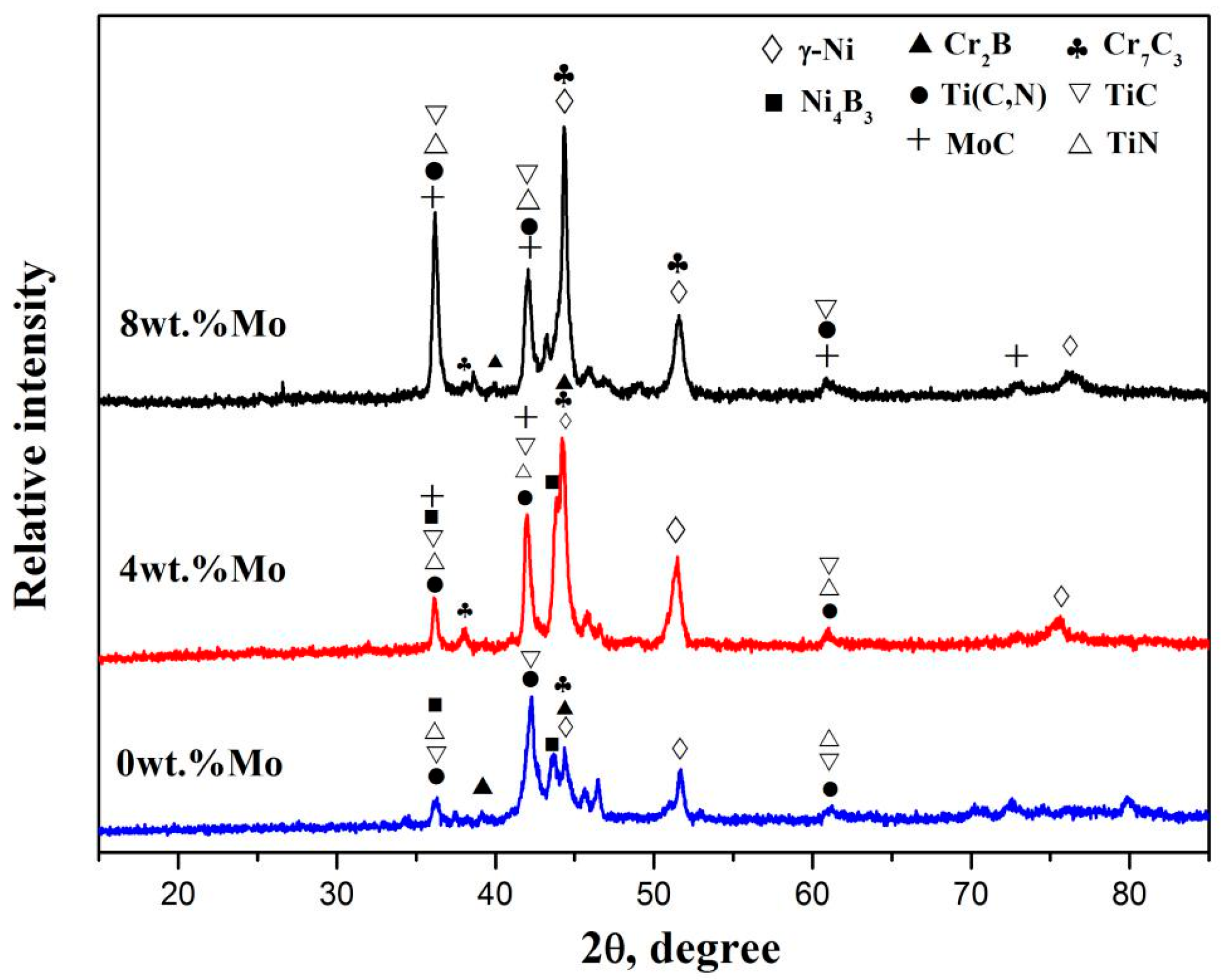
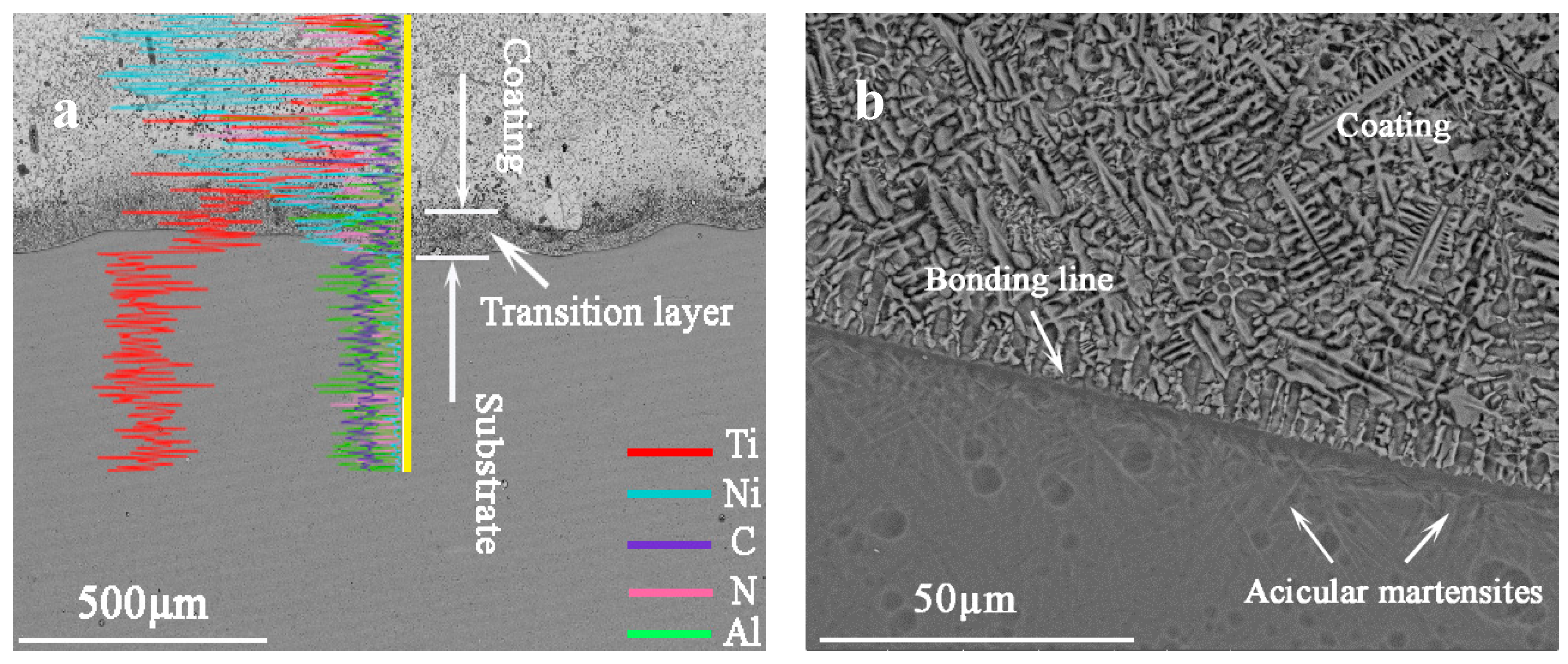
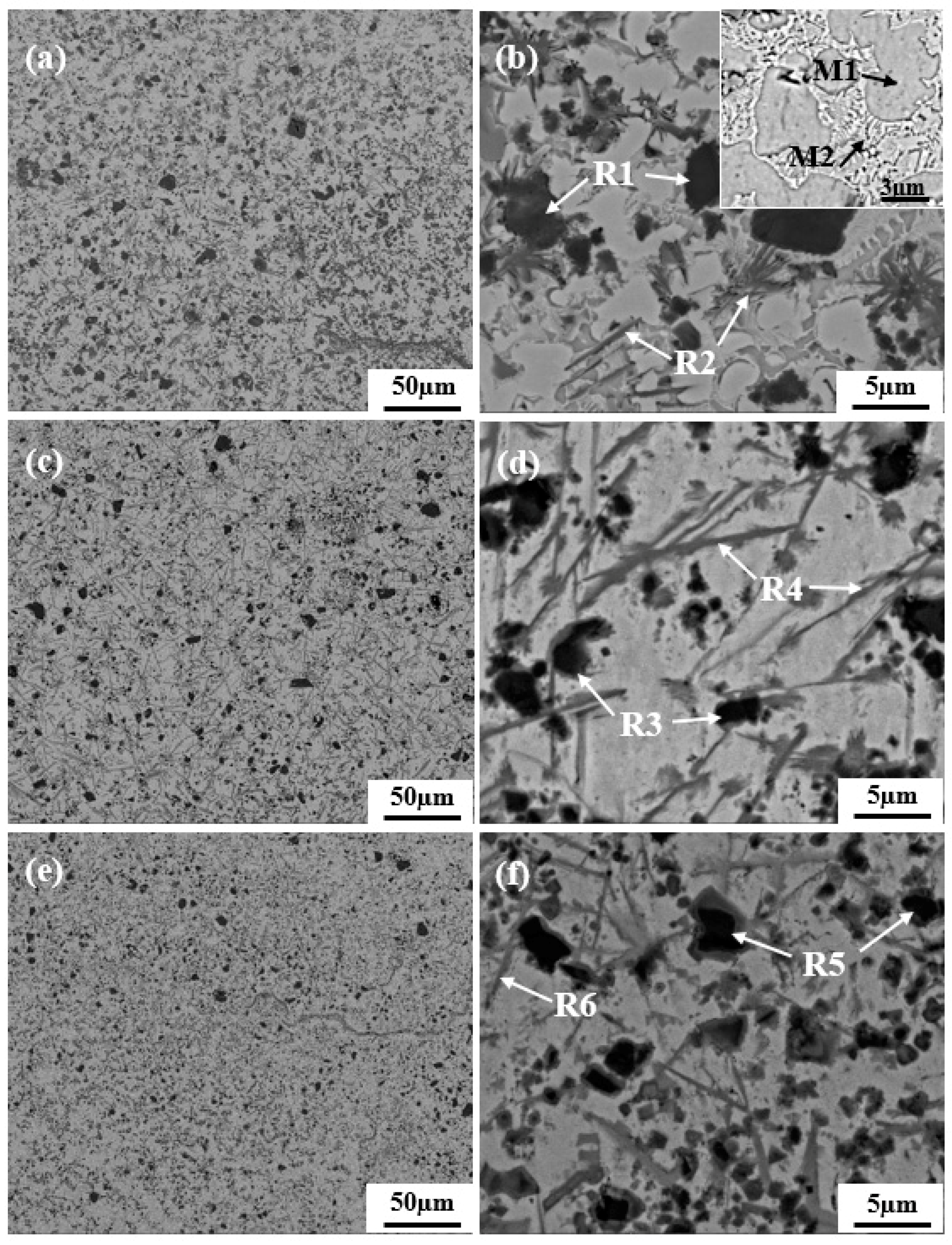
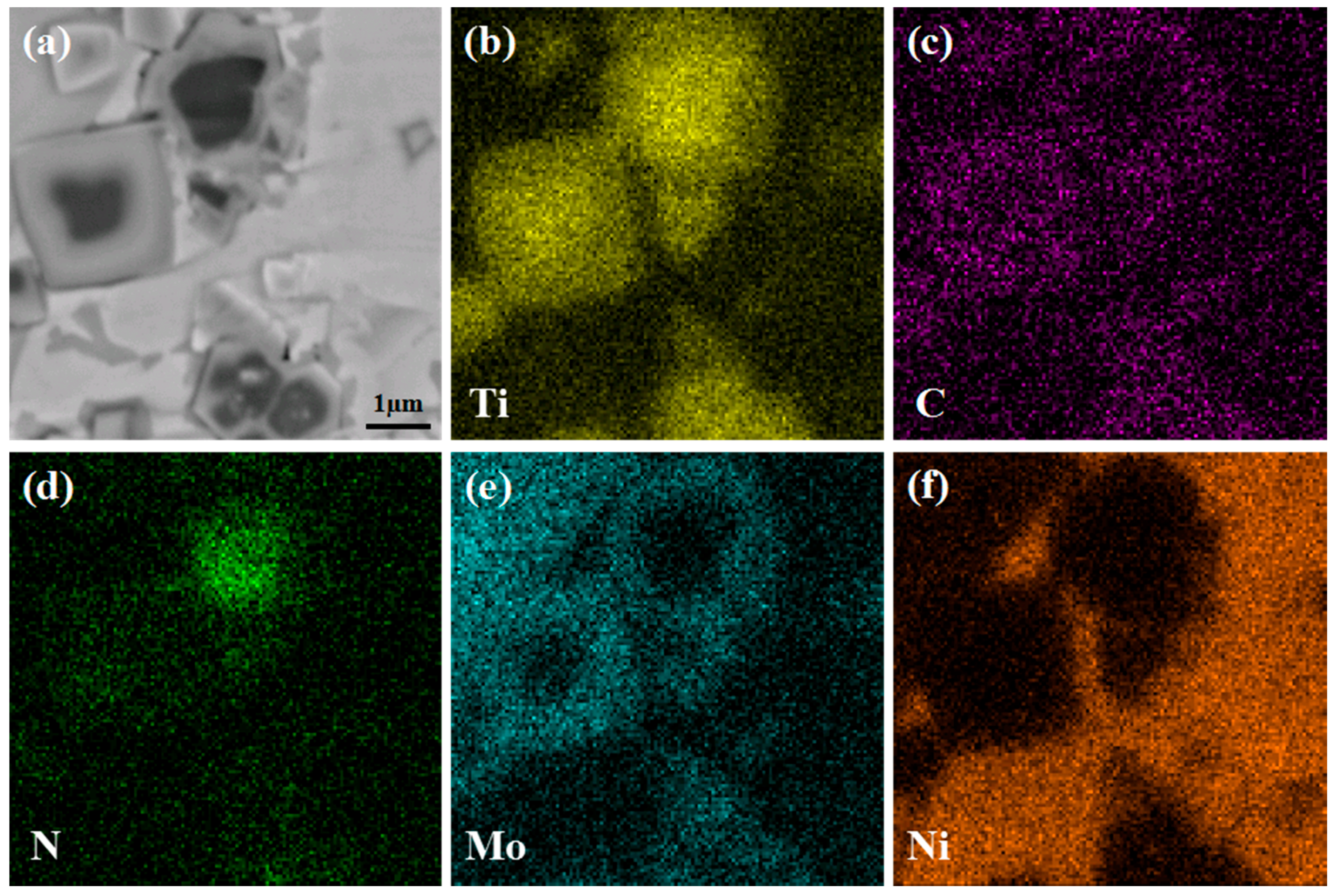
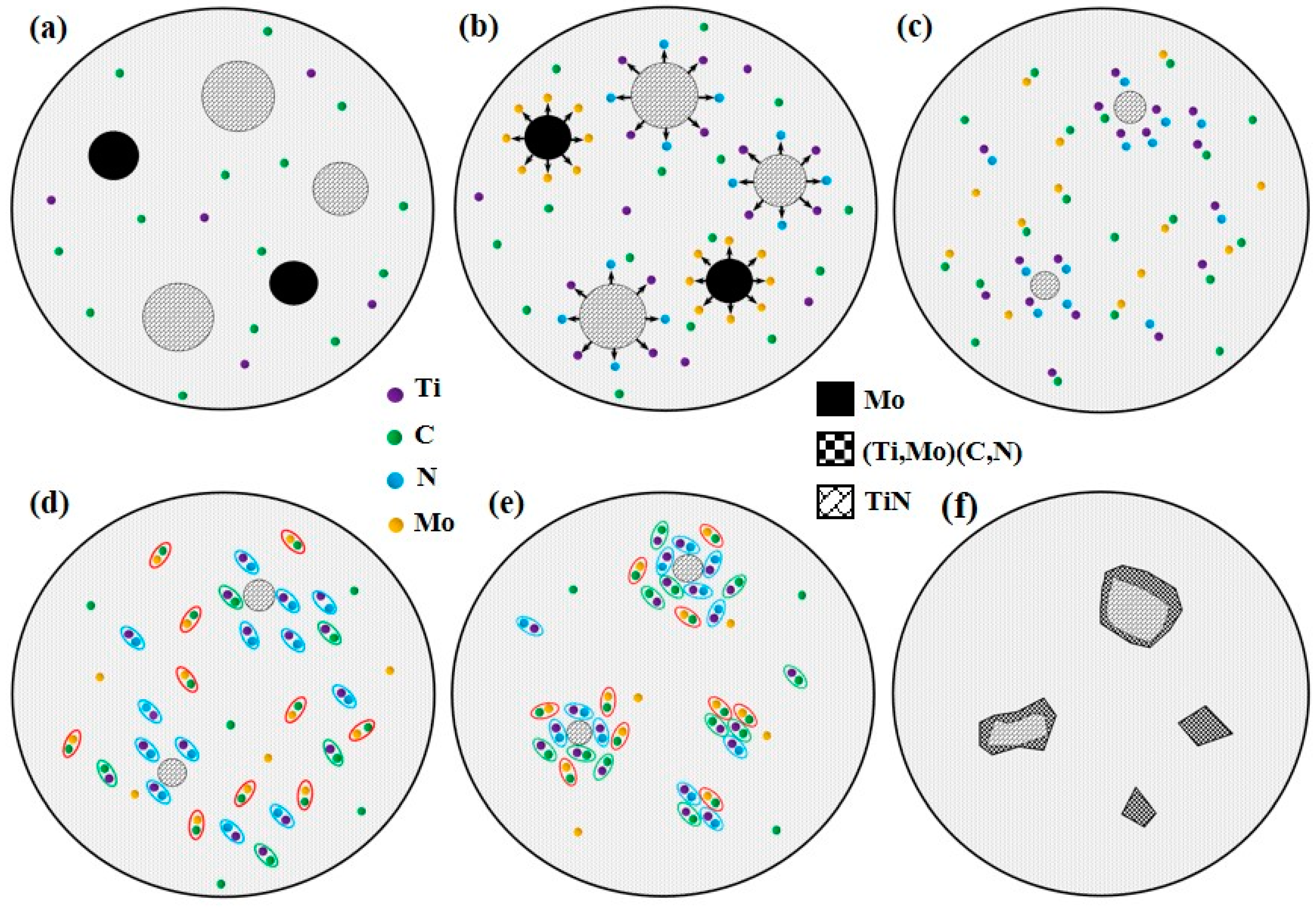
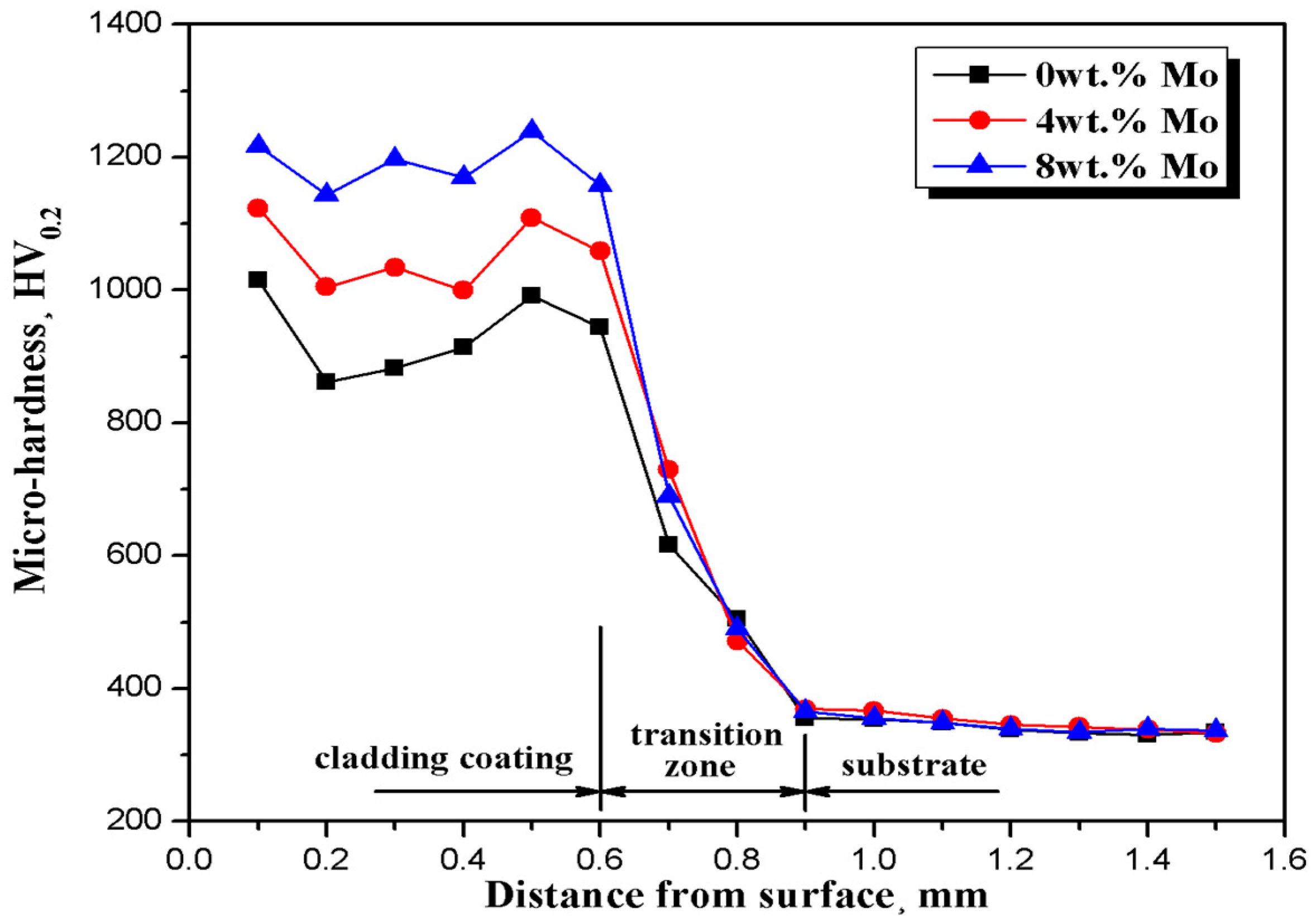
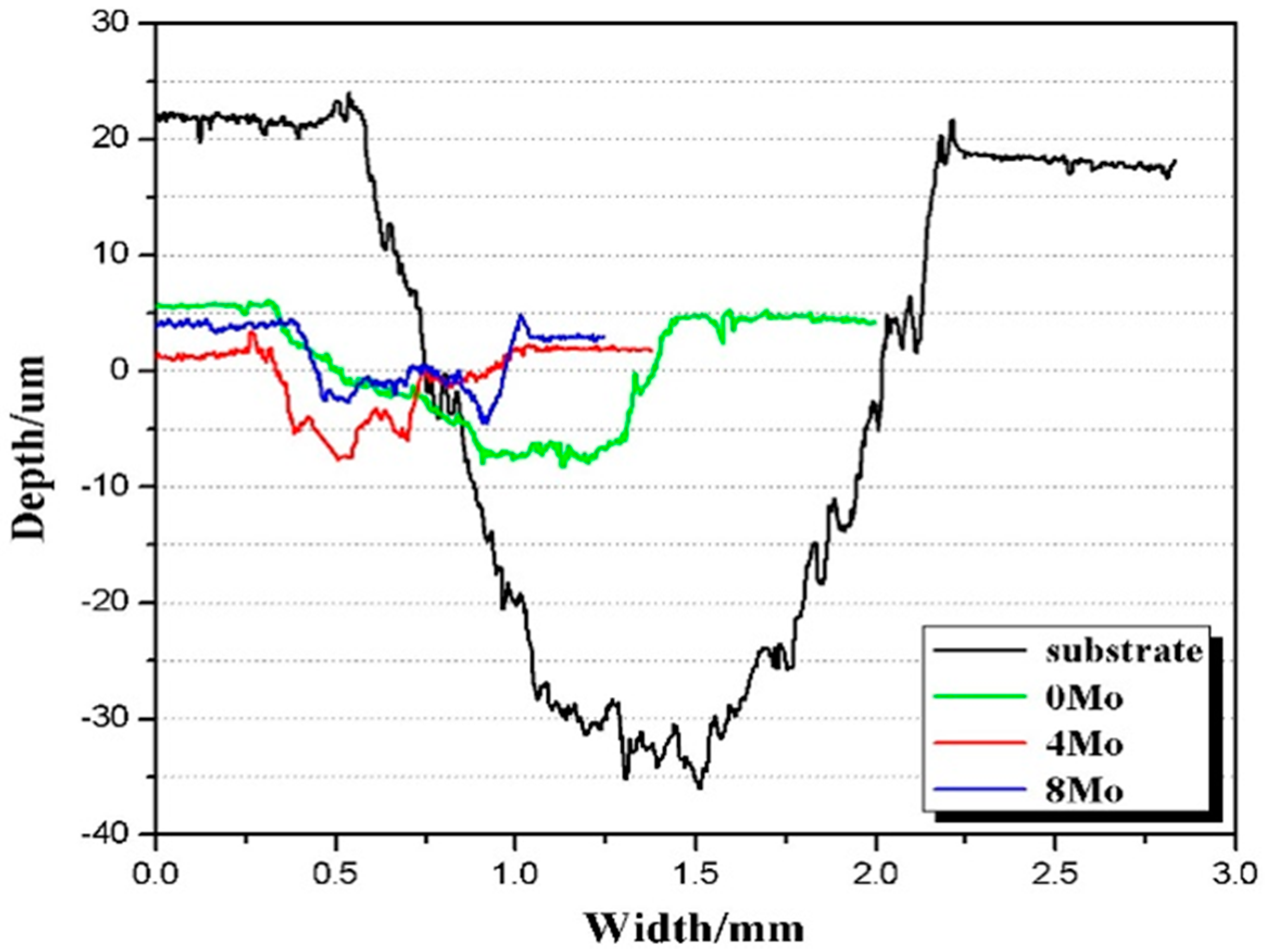
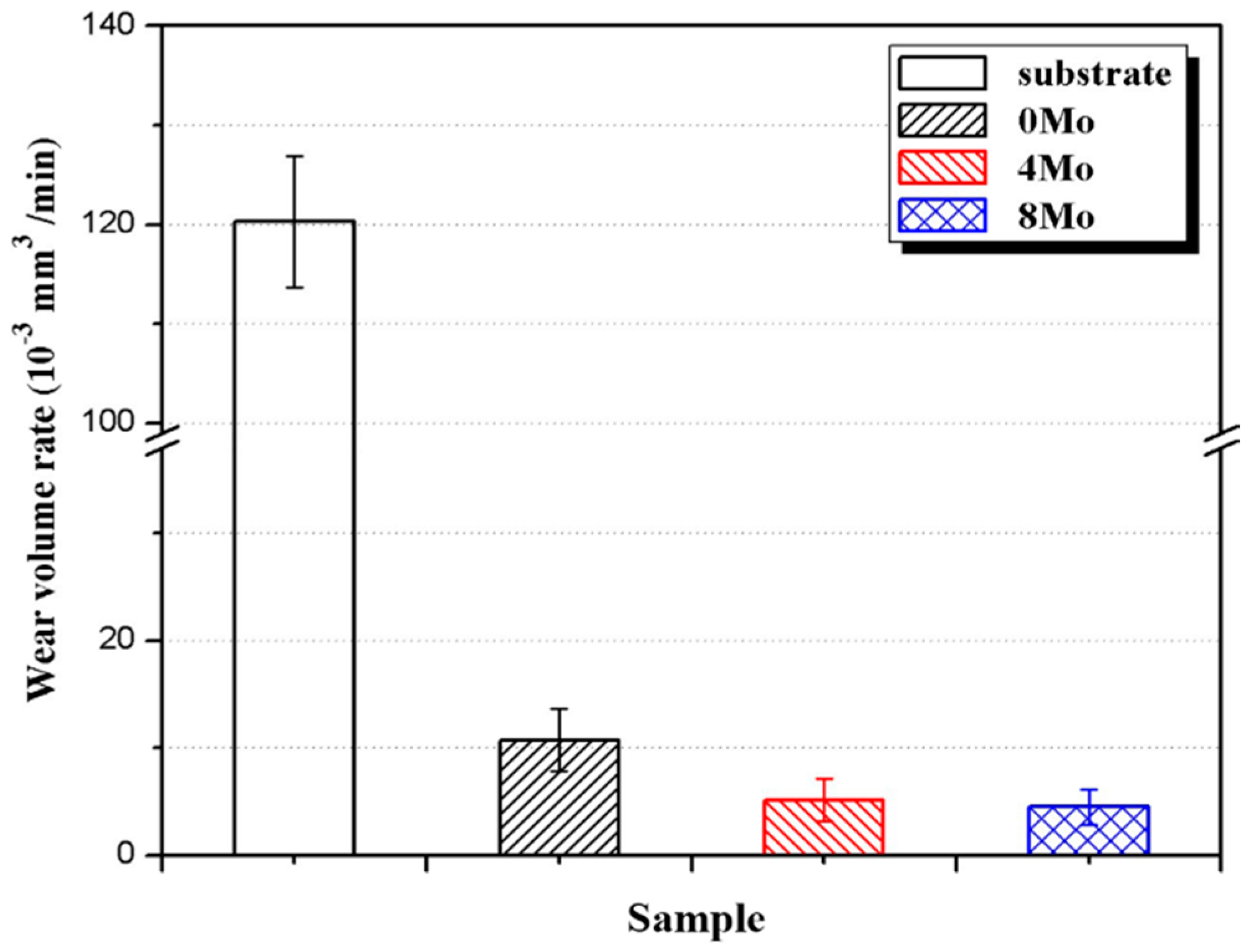

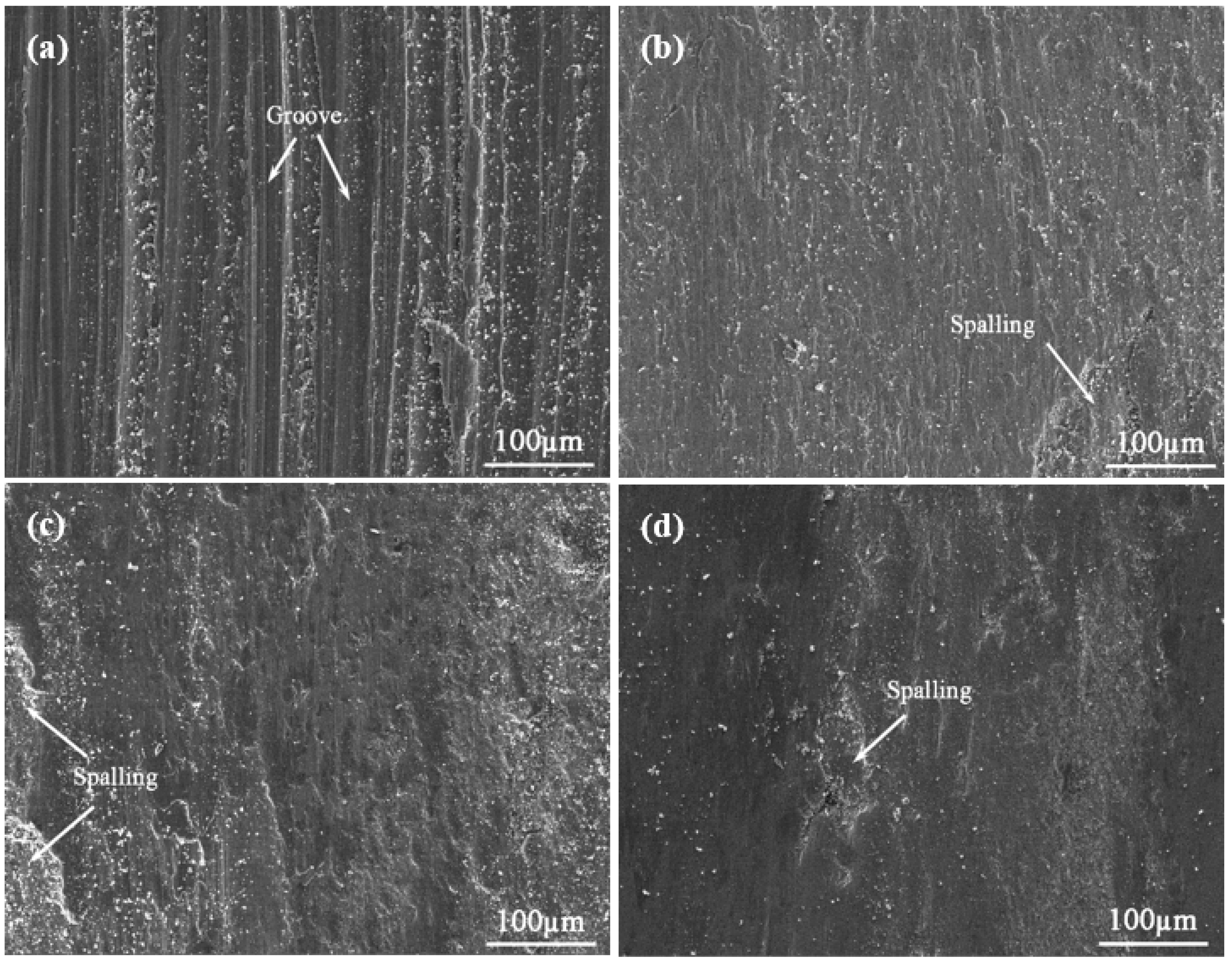
| Cr | Fe | W | Si | B | C | Ni |
|---|---|---|---|---|---|---|
| 15.5 | 15 | 3 | 4 | 3.5 | 0.65 | Bal. |
| Number | Powder Composition (wt %) | Laser Power (W) | Scanning Speed (mm/s) | Spot Diameter (mm) |
|---|---|---|---|---|
| Sample 1 | 88Ni60-2C-10TiN | 500 | ||
| Sample 2 | 84Ni60-2C-10TiN-4Mo | 2 | 3 | |
| Sample 3 | 80Ni60-2C-10TiN-8Mo |
| Phase | Ti | N | C | Fe | Cr | B | Ni | Mo |
|---|---|---|---|---|---|---|---|---|
| M1 | 3.02 | - | 12.24 | 10.90 | 8.13 | - | 65.71 | - |
| M2 | 3.99 | - | 15.45 | 2.49 | 7.29 | 8.66 | 62.12 | - |
| R1 | 33.00 | 34.65 | 27.35 | 1.26 | - | 3.74 | - | |
| R2 | 1.63 | - | 17.60 | 27.92 | 50.03 | 2.82 | - | |
| R3 | 43.55 | 39.62 | 16.83 | - | - | - | - | |
| R4 | 0.92 | - | 27.82 | 19.07 | 44.90 | 6.92 | 0.37 | |
| R5 | 33.43 | 55.48 | 10.44 | - | - | - | 0.65 | |
| R6 | 2.70 | - | 25.26 | 17.26 | 42.96 | 8.04 | 3.78 |
© 2017 by the authors. Licensee MDPI, Basel, Switzerland. This article is an open access article distributed under the terms and conditions of the Creative Commons Attribution (CC BY) license (http://creativecommons.org/licenses/by/4.0/).
Share and Cite
Wu, F.; Chen, T.; Wang, H.; Liu, D. Effect of Mo on Microstructures and Wear Properties of In Situ Synthesized Ti(C,N)/Ni-Based Composite Coatings by Laser Cladding. Materials 2017, 10, 1047. https://doi.org/10.3390/ma10091047
Wu F, Chen T, Wang H, Liu D. Effect of Mo on Microstructures and Wear Properties of In Situ Synthesized Ti(C,N)/Ni-Based Composite Coatings by Laser Cladding. Materials. 2017; 10(9):1047. https://doi.org/10.3390/ma10091047
Chicago/Turabian StyleWu, Fan, Tao Chen, Haojun Wang, and Defu Liu. 2017. "Effect of Mo on Microstructures and Wear Properties of In Situ Synthesized Ti(C,N)/Ni-Based Composite Coatings by Laser Cladding" Materials 10, no. 9: 1047. https://doi.org/10.3390/ma10091047





